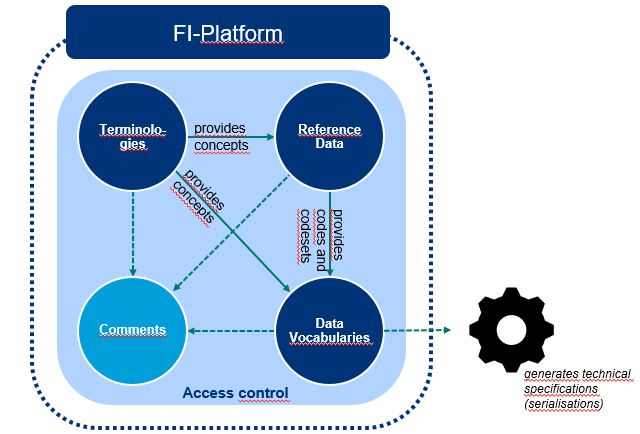In spring 2024, the Digital and Population Data Services Agency (DPDSA) implemented a project funded by the CBDS programme of the Nordic Council of Ministers. Project's objectives included modelling a few proposals for the evidence that could be exchanged in the Once Only Technical System (OOTS) using the Data Models tool of the Interoperability Platform (FI-Platform).
The project’s evidence proposals were modelled with the support of the KEHA Centre’s Digital Single Market Team. In the future, these will be utilised and supplemented with national competent authorities, in the SDG-related collaboration between the Nordic and Baltic countries, and in the EU Commission’s sub-group for standardising OOTS data.
The Interoperability Platform can be used to model the data contents of data resources
The Interoperability Platform maintained by the Digital and Population Data Services Agency provides the tools for defining interoperable data contents. The platform consists of terminologies, code sets, and data models that are available for terminological work, code set management, and data modelling.
The platform’s Data Vocabularies Tool is a service for maintaining and publishing semantic data models, and it contains the general core data specifications necessary for data harmonisation. This core data is used in descriptions that are made for a specific purpose, such as presenting the data content of a specific theme, application, or interface. This helps ensure the consistency of any detailed descriptions based on common core data, i.e. application profiles, than if they were individually defined.
The project included the modelling of two OOTS core data models and four evidence proposals
The project used the Data Vocabularies Tool to model two core data models – one from population data and one from education data – as the basis for evidence transmitted in the OOTS.
Based on these core data models, four evidence proposals were modelled into the Data Vocabularies Tool as application profiles:
- Birth certificate
- Residence certificate
- Secondary education degree certificate
- Transcript of records of tertiary education
The data requirements defined by the SDG Regulation’s Evidence Mapping sub-group served as the basis for the OOTS core data models and evidence. The information requirements are common to all EU Member States, and they form the basis for evidence in several of the procedures defined in Annex II of the SDG Regulation, such as applying for tertiary education and study benefits.
The data models made use of terminologies
The core data models and evidence proposals utilised the OKSA Education and Training Terminology as well as the EU core terminology specified in the Interoperability Terminology for the Finnish Public Sector, which are both available in the Interoperability Platform’s Terminologies Tool. In the future, the project’s results can be further refined with the help of ELMO and EU core data (core vocabularies) once they are available in a machine-readable format.
The creation of a common SDG OOTS vocabulary based on EU core terminology would facilitate the further development of existing evidence and the modelling of new evidence for the needs of all Member States.
The project also helped clarify the guidelines for the Data Vocabularies Tool
In the second part of the project funded by the CBDS programme, the DPDSA improved the guidelines for data modelling and also translated the guidelines into English. The tool’s guidelines serve a vital role, as they help the tool’s users make the most of its various functions. The translated guidelines will also help expand the Data Vocabularies Tool’s audience, as it can now be used to publish multilingual data specifications created in both national and international projects.
To browse the English translations of the teaching materials, select this link.
